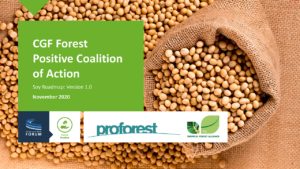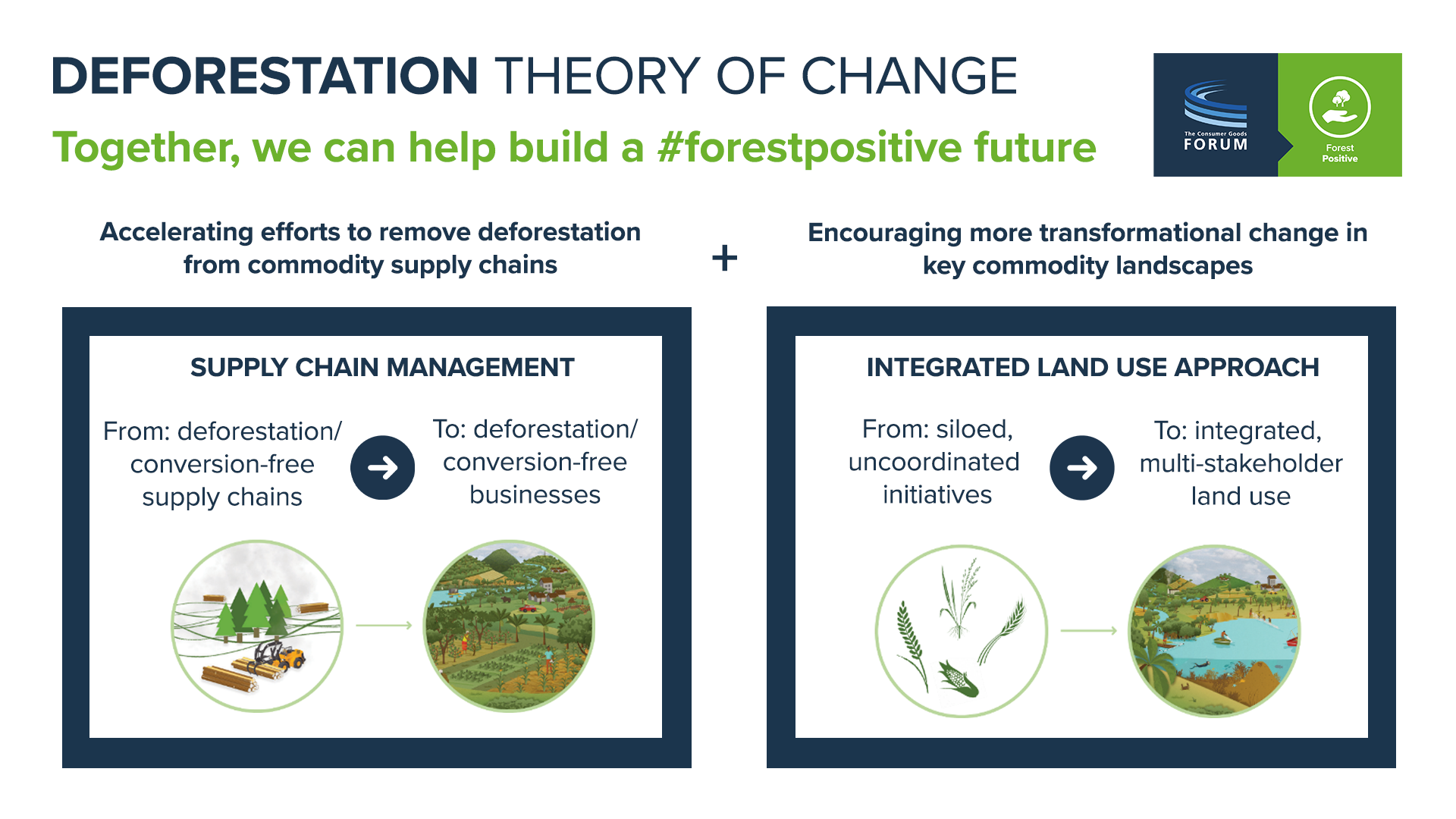Achieving a forest positive future: that is the goal set by the 18 member companies of The Consumer Goods Forum (CGF) Forest Positive Coalition as they work to transform the supply of three commodities — palm oil, soy, and paper, pulp and fibre-based packaging — driven by a Theory of Change that believes it will be only through collaboration that Coalition members can achieve this goal. In the Coalition’s Soy Working Group, this belief is why we have spent the last 10 months building a shared understanding of underlying issues in the soy sector and working together to define a common vision, goals, and a plan of action to ensure our soy supply is forest positive.
A Roadmap to a Forest Positive Future
The first edition of the Soy Roadmap, which will guide Coalition members’ actions toward sourcing sustainable soy, is the result of that collaboration. It contains specific commitments around individual and collective actions that Coalition members will implement to drive change, and recognises equal responsibility but different activities for direct soy buyers and users of embedded soy. Here we share the key details of the Roadmap which will make achieving a forest positive future for soy possible.
Collaboration is Key
Soy is one of the largest drivers of deforestation among agricultural commodities and collaboration throughout the whole supply chain is especially important in the sector for several reasons. Compared to other commodity supply chains, it is particularly challenging to tackle deforestation and other sustainability risks in soy production because the soy supply chain consists of a complex set of actors in different countries and involves many levels of transformation. For example, soy can be transported for thousands of kilometres before it is crushed. It is therefore difficult to establish how much soy is in a company’s supply chain. There are constant changes in the supply base as buyers respond to the fluctuating market and price changes, also making long-term contracts with producers uncommon. All these factors make it difficult to establish relationships across the supply chain that can be leveraged to drive change – that is why encouraging collaboration here is key.
Feedback Helps Strengthen Our Approach
Consulting with external stakeholders is also key in ensuring that the actions that we have laid out are comprehensive and in line with external expectations. We organised a consultation process facilitated by Proforest and the Tropical Forest Alliance with civil society organisations, industry associations and supply chain companies. Thanks to this ongoing consultation, we were able to make significant improvements to the Roadmap, such as sharpening its commitments and ambitions; developing more clarity on the details of the Coalition Ask to traders and suppliers; and adding more definition to the reporting and transparency process.
Supply Chain Engagement Will Play a Central Role
As part of the collaboration needed to drive change in the soy sector, we are focused on collectively engaging key soy traders and suppliers to deliver on commitments across their entire businesses. We will do this by communicating the Coalition’s expectations (our “Coalition Ask”) and monitoring their performance, and also by finding opportunities for collaboration and alignment to drive sector-wide transformation. In the Roadmap, we also commit to support a shared understanding of high-risk origins in the sector through working with key actors, including local stakeholders, and using this information to implement effective responses through engaging with suppliers and traders and in priority landscapes and regions.
Clear Cut-off Dates Encourage Accelerated Action
We know from the alarming rates of deforestation worldwide that action is needed now, and the Roadmap includes an explicit commitment from members to eliminate legal and illegal deforestation and conversion of natural ecosystems to soy in their supply chains. Coalition members must also have a public, time bound action plan for delivery, including clear cut-off and target dates that are consistent with Accountability Framework Initiative (AFi) and Collaboration for Forests and Agriculture (CFA) deforestation- and conversion-free (DCF) Regional Guidance. (A cut-off date specifies the permissibility of deforestation or conversion based on the timing of such events on the ground. This means that any clearance of natural forest after the cut-off date will render the affected area or production unit, and the commodity produced there, non-compliant with no-deforestation commitments.) The Roadmap explains cut-off dates adopted for different biomes must align with sectoral cut-off dates where they exist (e.g. the Amazon Soy Moratorium, legal cut-off dates) and be no later than 2020 for the rest.
We are Learning as We Go
Developing the Roadmap was not always easy. Coalition member companies differ in size, sourcing areas, and have different types of supply chains, for instance. Members are also joining the Coalition at different stages in their forest positive journeys. Finally, there are the anti-trust framework and competition laws to which we must abide. However, we found that most of these differences turned out to be enablers and catalysts to drive conversations, learn from each other’s experiences, networks, and knowledge, and to define our common way forward.
It’s Time for Action
In the context of an agricultural commodity like soy, for which buyers are very diverse but suppliers fairly concentrated, we see a great opportunity in finding the right balance between individual and collective action when tackling the key sustainability challenges facing the value chain. Consumer good companies may offer different products using soy, from pet food to plant-based burgers, but we all rely on the same natural landscapes for the long-term success of our businesses.
Doing our part to create a forest positive soy sector means understanding root causes and local dynamics, defining the appropriate paths of action and performance indicators to keep us on track, and also prioritising where the most positive impact can be achieved over time. We recognise the challenges of multi-stakeholder alignment and also the flaws of limiting them to one sector or one stage of a value chain. For these reasons, one of our key work streams intends to leverage and co-create solutions with the most relevant levers of our stakeholder ecosystem: within the value chain, a country, a region, and a sector. We will thoughtfully progress within realistic engagement boundaries.
Now that our collective ambition is clear, and we have a Roadmap to guide our actions, we are looking forward to accelerating progress by working individually and collectively to implement commitments through time bound action plans and clear targets. Building on the progress made by other initiatives in the soy sector, the Soy Working Group will focus on actions where members’ collaboration can add the most value towards a forest positive sector. The challenges of the soy sector and need for accelerated action have become common sense, and the ambition to become forest positive businesses is now clear to all of us. Making tangible progress towards this goal is what our collective Soy Roadmap is all about.


